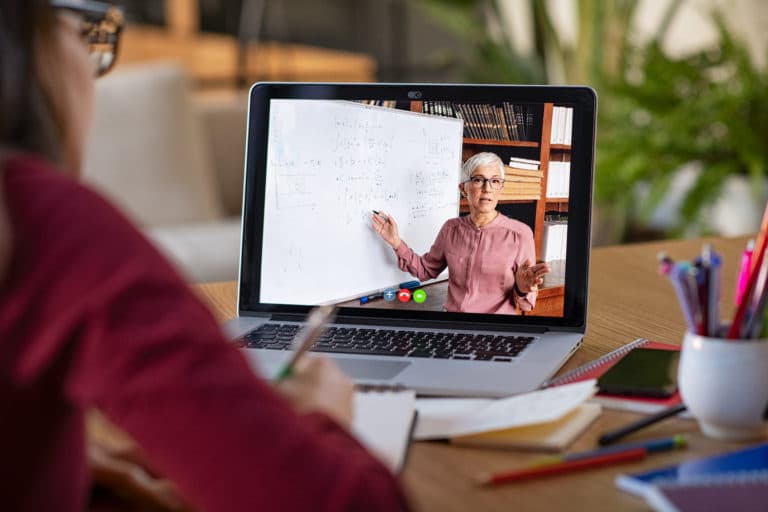
Class is the next generation virtual classroom for K-12, higher education, government agencies, and the workplace. Contact us today to schedule your live demo and see Class in action.

Class is the next generation virtual classroom for K-12, higher education, government agencies, and the workplace. Contact us today to schedule your live demo and see Class in action.

How do I manage a classroom of students that are tired of remote learning? How do I manage a hybrid classroom? These remote classroom management questions are top of mind for teachers at all levels of education as they adjust to the new normal of hybrid teaching, remote classrooms, and virtual learning tools.
Andrew Selepak, PhD., is a media professor at the University of Florida, and program coordinator of the graduate program in social media. In spring 2020, he switched four in-person courses online during the middle of the semester. Then, he taught virtually in the summer and fall and is now teaching four hybrid courses. “Hybrid, live online, and asynchronous teaching are all different,” he notes. “But the one thing they all have in common is that when students are not in the classroom, it is much easier for them to get distracted.” That’s why effective remote classroom management tips are so important.
There are a variety of methods that teachers at both the K-12 and higher ed levels are finding effective for hybrid teaching, and there are a number of virtual learning tools that can help to engage students in the hybrid teaching environment. Here are “5 Remote Classroom Management Tips for 2021.”
Instructors have to do more than just deliver information in the hybrid environment, says Selepak. They almost, he says, have to become quasi-entertainers. “You have to constantly stimulate students to keep their attention on you and your lecture and not their phones, another tab on their browser or any other distractions,” he says. Selepak says he does this “by having images and .gifs on multiple slides, giving examples not included on the slides and frequently asking students questions.” Movement—whether on the slides with animations or through their own body movement—can also help augment a “talking head” on the screen, he says.
It’s also good to change the pace of delivery and add inflection to your voice to avoid being monotone, says Selepak. “Our brains will react, and we pay attention when something changes, whether that is visual or sound, and using different voices or changing the pace or inflection of my voice helps reorient students back to the lecture,” he says.
Robert Kienzle is an associate professor in the graduate school of business at Sungkyunkwan University where he teaches online communication courses for MBA students, as well as Fortune 100 companies. All of his classes are interactive, he says, and he tracks who has participated to identify those who may need to be called on during class.
“Knowing I call everyone throughout a class keeps people’s attention,” he says.
In addition, Kienzle has found some online remote learning tools and third-party apps to be useful for incorporating hands-on activities into his classes. “Miro is an example of a supercharged whiteboard and collaboration tool,” he says. He’s also used “online ‘wheels of names’ that spin to choose the next speaker. Students love watching the wheel to see who it will land on.”
By giving students something hands-on to do, “they will have more fun, pay more attention and, ultimately, learn more in class,” Kienzle says.

Social studies teachers Julie Kaner, Nellie Brooke and Monica McFerrin at Austin Middle School in Irving, Texas, say that one of the biggest lessons they’ve learned this year to manage remote classrooms is to be as “real” as possible. They also point to the importance of building relationships with remote learners just as teachers would with in-person students. In addition, they recommend:
Use all of the technological resources available to you to create the most “real” classroom and learning environment possible for remote learners, they suggest. And don’t be afraid to experiment. “Trial and error is key to making the technology work as efficiently and effectively as possible,” they say.
Ben Davidson, ESOL coach at Baltimore City Public School’s the Holabird Academy, says he has “learned that you need to go slow to go fast with regard to student computer literacy and their abilities to successfully engage with online activities and tools.” Don’t assume that they already know or can quickly pick up on the actions necessary to engage in the remote learning environment.
“For example, you can plan the most engaging and exciting project, but if students do not yet know how to copy and paste or navigate multiple tabs, then the project will fall flat,” says Davidson. “As educators, we need to stop and reflect to check our own assumptions about how ‘tech-savvy’ young people are—the range of skill levels is really wide.”

Beverly LaZar is a special education teacher at San Antonio STEM Magnet Elementary/Albuquerque Public Schools in Sandia Park, New Mexico. Remote or hybrid classroom management is about building relationships with students, says LaZar. “The better bond I build with my students, getting to know them as individuals and allowing them space to get to know one another as well creates a cohesive classroom community,” she says.
These connections make it easier to work together, including during times when students may need redirection. “If a student needs space for further redirection, I can easily move that student and myself into an online breakout room to discuss things more privately,” she says.
Mastering remote classroom management builds on the same tried and true principles of effective teaching that teachers have always incorporated into their lesson planning. In addition, though, teachers need to give consideration to the steps they can take to build effective online relationships and replicate the real-world teaching and learning experience with virtual learning tools.

Class is the next generation virtual classroom for K-12, higher education, government agencies, and the workplace. Contact us today to schedule your live demo and see Class in action.

Class is the next generation virtual classroom for K-12, higher education, government agencies, and the workplace. Contact us today to schedule your live demo and see Class in action.
Get our insights, tips, and best practices delivered to your inbox

Sign up for a product demo today to learn how Class’s virtual classroom powers digital transformation at your organization.

Features
Products
Integrations